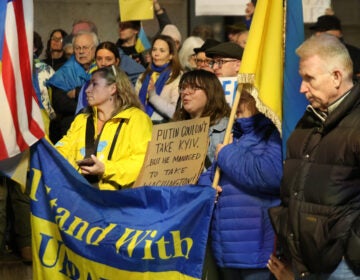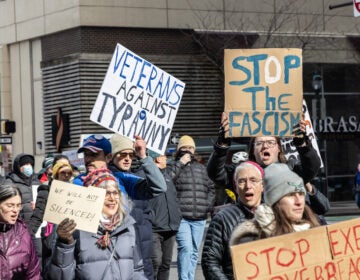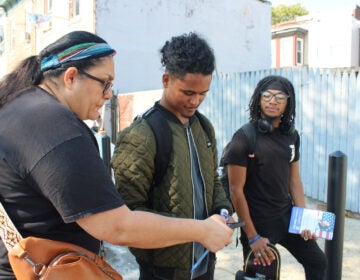In the Trump Era, Philadelphia is in crisis control

Demonstrators are shown at march in honor of International Women's Day, March 8, 2017, in Philadelphia. (Bastiaan Slabbers for NewsWorks, file)
While previous protest movements such as Occupy Philadelphia and the Movement for Black Lives have built a resurgence of popular action for the past several years, they have effectively coalesced into a single, many-faceted movement against the new president.
On March 8, Philadelphians assembled in Logan Circle for a demonstration on International Women’s Day. It was sunny and windy, and the participants brought their resolve and a sense of sustained commitment to new fronts of struggle, such as transgender rights and institutionalized xenophobia. Several speakers decried the president, his administration, and a system that the several hundred in attendance felt had failed them too often.
They marched to the Municipal Services Building, and convened later at the William Way LGBT Center for a discussion. Here was the atmosphere of a burgeoning movement gathering numbers and finding its way, with many less-experienced protesters in conversation with longtime more radical activists. Panelists representing the event’s organizers, local political parties Philadelphia Socialist Alternative, Philly Socialists and the Philadelphia chapter of the Party for Socialism and Liberation, fielded questions from a room packed with concerned citizens.
“How will we deal with the attacks on health care and housing?” “What will we do to address the need for racial justice?” “What would an alternative system look like?” All of these long-standing questions have taken on a new significance and urgency in the wake of an event that, to these people, had been catastrophic: the election of Donald Trump as the 45th president of the United States.
Mobilization
This type of mass action has become a regular fixture of life in Philadelphia in 2017. While previous protest movements such as Occupy Philadelphia and the Movement for Black Lives have built a resurgence of popular action for the past several years, they have effectively coalesced into a single, many-faceted movement against the new president, whose acts on immigration, on the Dakota Access and Keystone XL Pipelines, on the rights of women, people of color and LGBTQI people represent everything that these various groups despise.
The first anti-Trump action in the city, which took place on November 9th in immediate response to the election, was one of immense spontaneity and immense energy, ultimately numbering in the thousands. With time, this pure upheaval has transitioned into a more premeditated movement led by an enclave of leftist and moderate organizations, including Philadelphia Socialist Alternative, Philly Socialists, Black and Brown Workers’ Collective, Antifa Coalition, Black Lives Matter Philadelphia, Reclaim Philadelphia and Philadelphia Equality Coalition.
The trajectory of these actions foretells a promising level of organization. A unified front is forming between Socialist Alternative, Philly Socialists, and the Philadelphia chapter of Democratic Socialists of America; and these socialist organizations are collaborating hearteningly with liberal groups such as Reclaim Philadelphia and Philly We Rise.
The Left’s disillusionment with the 2016 election has resulted in an increasing interest in foundational, systemic change, as opposed to attacks on the president or the current administration alone. Additionally, many of the people active in these demonstrations entered politics during and after the campaign of Democratic candidate Bernie Sanders, whose “democratic socialism” pulled in a young generation, reducing the stigma that socialism developed during the Cold War.
These liberal coalitions have become apparent since the events staged in solidarity with the J20 and Women’s Marches taking place in Washington D.C. and nationwide on inauguration weekend. The main objective has been to challenge the platforms of the new president, which were perceived to be xenophobic, homophobic, racist, and misogynistic.
Measures and countermeasures
As these platforms have been carried into action, the people have gained new and more tangible reasons to assemble, including the ICE raids on the homes of 678 undocumented immigrants on the week of Feb. 6 and the repeated travel bans ordered by the president against individuals from the Western Asian and African countries that have been under assault by the U.S. military during the previous two administrations.
In late January, hundreds of protesters converged outside the Philadelphia International Airport to the travel ban. That evening the American Civil Liberties Union convinced a New York judge to order an emergency stay of execution to prevent the deportation of travelers who had entered the country. On Feb. 9, federal judges of the 9th Circuit ruled against reinstating the travel ban, and on the Feb. 14, Judge Leonie Brinkema of Virginia issued a preliminary injunction against the ban, calling it “unconstitutional.”
These events marked the first victory against the new administration, showing the people that placing pressure on the government through mass action could work. Trump would not take this offensive lying down, however, as he showed when he announced a new travel ban, which took effect last week.
Meanwhile, continued allegations of the Trump campaign’s ties to Russia have dogged the administration and emboldened the growing liberal resistance around the country. February and March saw the “Day Without Immigrants” and “Day Without Women” actions, respectively.
Implications
It is vital to the continued success of this movement that the administration’s actions under the auspices of national security are seen in the context of their fundamental racism, as stressed by such radical groups as Philly Real Justice. It is important to note that if the travel ban were really about religious intolerance, it would involve an objection to Islam itself in its foundational principles, as was the case during the Crusades, or with the persecution of Japanese Christians in the 16th century. Instead, the ban, like the raids of undocumented immigrants, is based on the premise that people from certain regions of the world must be assumed to be dangerous or criminal, which is a definitive example of racism. Indeed, under Trump, non-Muslim Arabs have also been subjected to detainment and refusal of entry.
Unfortunately, in this society, the identity of “Muslim” is conflated with all peoples from North Africa, West Asia, Southern Central Asia, and South Asia, regardless of their religion. Even Indian Sikhs are seen as “Muslims” through that lens. Meanwhile, European countries with majority-Muslim populations such as Turkey, Kosovo, and Albania were not included in the ban. American intelligence has no more reason to believe that travelers from the included countries pose a risk of violence than travelers from the European Muslim countries. The Arabic countries that are left off of the banned list, meanwhile, such as Saudi Arabia, Jordan, and, in the second turn, Iraq, are countries with which the United States has political ties.
Likewise, the calls to preserve the rights of women and LGBTQI people must work toward collaboration and unity among disparate intersecting communities. If the unique experience of, for example, transgender women of color are not acknowledged in these liberal political movements, they will become lost in the overwhelming narrative of the dominant culture. Different political elements must organize together toward the common goal of combating these executive measures. If the Left succumbs to combative factionalism, they will give the tactical advantage to their opponents.
Nothing, however, can guarantee victory over the new challenges that this administration poses. The future is uncertain. Movements come and go. The outcome of history is entirely up to the ones who make it.
WHYY is your source for fact-based, in-depth journalism and information. As a nonprofit organization, we rely on financial support from readers like you. Please give today.




